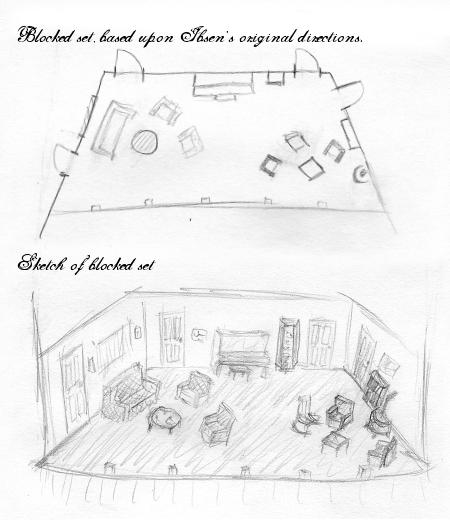Ibsen’s “A Doll’s House” set design
29 Oct 2004It’s been said previously that Ibsen’s set directives at the beginning of A Doll’s House simply don’t work. Just to prove them wrong (or possibly right!), I decided to block up a set from his directives, which, in the translation used by Project Gutenberg, reads as follows:
A room furnished comfortably and tastefully, but not extravagantly. At the back, a door to the right leads to the entrance-hall, another to the left leads to Helmer’s study. Between the doors stands a piano. In the middle of the left-hand wall is a door, and beyond it a window. Near the window are a round table, arm-chairs and a small sofa. In the right-hand wall, at the farther end, another door; and on the same side, nearer the footlights, a stove, two easy chairs and a rocking-chair; between the stove and the door, a small table. Engravings on the walls; a cabinet with china and other small objects; a small book-case with well-bound books. The floors are carpeted, and a fire burns in the stove.
From this, my sketch (which would probably work in most performance spaces, assuming they’re not too unusual — in which case, you should be used to having to butcher directives in order to get a working set!):

Of course, I’m completely unfamiliar with the design conventions of the period (speaking generally, not of stage and set construction), so chances are furniture details are incorrect, as (most likely) is the style of the stove (stage left) and various other elements in the room. Notably, this block and sketch have been worked from a translation of the original text, so some elements may be different or incorrect due to misunderstanding after translation: The McLeish translation (arguably far less eloquent and watered down!) dictates a number of things different — the most significant being the description of “a small table” (as above) instead as “a side-table”.
I’d chosen to ignore the directive to place that furniture behind the stove, simply because it was simpler not to, and I’d forgotten about the bookcase (besides, there aren’t any compelling reasons to follow this directive, if I were to follow the Gutenberg or Archer version only — “a small table” may be placed anywhere, however the McLeish translation states “a side-table”, which requires a wall…).
For the record, I’m perfectly well aware I can’t sketch, so don’t bother reminding me! Having said that, there seems to be a distinct lack of set designs around that adhere to Ibsen’s directives, so perhaps this may be useful to someone. Oh, and this is just about proving a point, anyway. ;)